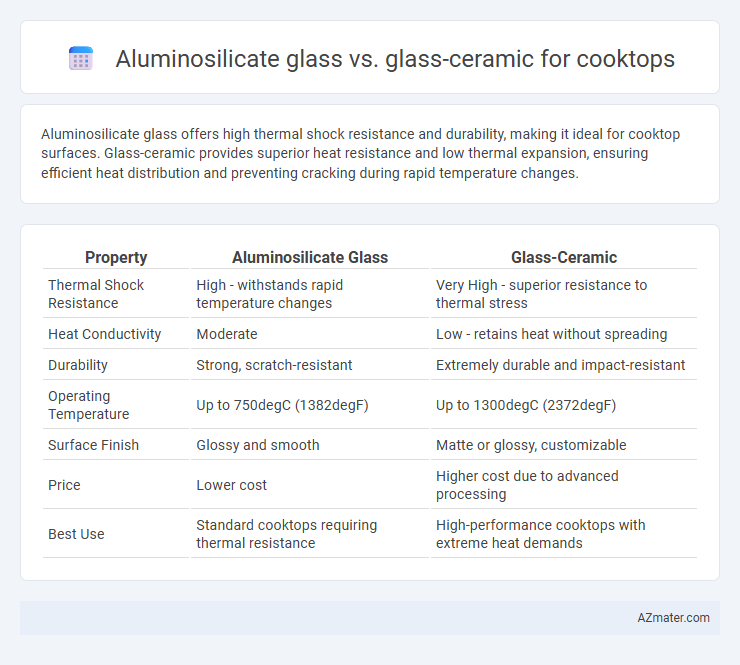Aluminosilicate glass offers high thermal shock resistance and durability, making it ideal for cooktop surfaces. Glass-ceramic provides superior heat resistance and low thermal expansion, ensuring efficient heat distribution and preventing cracking during rapid temperature changes.
Table of Comparison
| Property | Aluminosilicate Glass | Glass-Ceramic |
|---|---|---|
| Thermal Shock Resistance | High - withstands rapid temperature changes | Very High - superior resistance to thermal stress |
| Heat Conductivity | Moderate | Low - retains heat without spreading |
| Durability | Strong, scratch-resistant | Extremely durable and impact-resistant |
| Operating Temperature | Up to 750degC (1382degF) | Up to 1300degC (2372degF) |
| Surface Finish | Glossy and smooth | Matte or glossy, customizable |
| Price | Lower cost | Higher cost due to advanced processing |
| Best Use | Standard cooktops requiring thermal resistance | High-performance cooktops with extreme heat demands |
Introduction to Cooktop Surface Materials
Aluminosilicate glass offers high thermal resistance and mechanical strength, making it a durable choice for cooktop surfaces that withstand rapid temperature changes and heavy cookware. Glass-ceramic combines the properties of glass and ceramics, providing excellent heat resistance, low thermal expansion, and efficient heat conduction for more consistent cooking performance. Both materials are popular in modern cooktops for their sleek appearance and ability to endure frequent heating cycles without cracking.
What is Aluminosilicate Glass?
Aluminosilicate glass is a type of glass composed primarily of aluminum oxide and silicon dioxide, known for its exceptional thermal resistance and mechanical strength, making it ideal for cooktop surfaces exposed to high heat. It offers superior durability and scratch resistance compared to traditional glass-ceramic, which consists of crystalline phases embedded in a glass matrix designed for smooth heating. Aluminosilicate glass provides enhanced safety and longevity in cooktops due to its ability to withstand rapid temperature changes without cracking.
Understanding Glass-Ceramic Cooktops
Glass-ceramic cooktops feature a durable, heat-resistant surface made by controlled crystallization of glass, providing superior thermal shock resistance compared to aluminosilicate glass. The unique microcrystalline structure of glass-ceramics allows rapid, even heat distribution, minimizing hotspots and enhancing cooking performance. Unlike aluminosilicate glass, which offers high strength and scratch resistance mainly for protective purposes, glass-ceramic is engineered to withstand direct exposure to high temperatures typical in cooktops.
Thermal Resistance: Aluminosilicate vs Glass-Ceramic
Aluminosilicate glass offers superior thermal shock resistance compared to glass-ceramic, making it ideal for rapid temperature changes on cooktops. Glass-ceramic, while less resistant to sudden temperature fluctuations, provides excellent long-term thermal stability and can withstand higher continuous temperatures. For applications requiring frequent heating and cooling cycles, aluminosilicate glass reduces the risk of cracking, whereas glass-ceramic excels in maintaining structural integrity under sustained high heat.
Durability and Scratch Resistance Comparison
Aluminosilicate glass offers high durability with excellent resistance to thermal shock, making it less prone to cracking under rapid temperature changes compared to glass-ceramic cooktops. Glass-ceramic surfaces provide superior scratch resistance due to their crystallized structure, maintaining a smooth and glossy finish even after prolonged use. While both materials are robust, aluminosilicate excels in impact resistance, whereas glass-ceramic is better suited for everyday abrasion protection in cooktop applications.
Heat Distribution and Cooking Performance
Aluminosilicate glass offers superior thermal shock resistance and even heat distribution, making it ideal for cooktops requiring rapid temperature changes and consistent cooking surface temperatures. Glass-ceramic, known for exceptional heat retention and uniform heating, maintains stable surface temperatures, enhancing precise cooking control and reducing hot spots. Both materials improve cooking performance, but aluminosilicate glass excels in durability against abrupt temperature shifts, while glass-ceramic provides steady heat for prolonged cooking tasks.
Aesthetic Differences Between the Two Materials
Aluminosilicate glass offers a sleek, glossy surface with high transparency and a smooth finish, enhancing modern kitchen aesthetics. Glass-ceramic cooktops present a matte or slightly textured appearance with subtle crystallization patterns, contributing to a sophisticated and heat-resistant design. The choice between the two materials impacts the overall kitchen style, with aluminosilicate glass favoring a minimalist look, while glass-ceramic provides a more durable and visually complex surface.
Cleaning and Maintenance Considerations
Aluminosilicate glass cooktops offer a smooth, non-porous surface that resists stains and is easy to clean with standard cooktop cleaners, minimizing streaks and residue buildup. Glass-ceramic cooktops, while also smooth, are more prone to scratches and may require specialized cleaning products to avoid damage and maintain their radiant appearance. Regular use of non-abrasive pads and immediate cleaning of spills are essential for both materials to prolong their lifespan and ensure hygienic cooking surfaces.
Cost and Availability in Market
Aluminosilicate glass typically offers a lower cost and high availability in the market due to its widespread use in various cooktops and consumer electronics. Glass-ceramic cooktops generally come at a higher price point because of their enhanced thermal resistance and durability, but their availability is more limited to premium or specialized appliance brands. Consumers seeking cost-effective solutions often prefer aluminosilicate glass, while those prioritizing long-term performance may invest in the more expensive glass-ceramic options despite reduced market presence.
Which Cooktop Material is Best for You?
Aluminosilicate glass offers excellent thermal shock resistance and durability, making it ideal for everyday cooking with quick temperature changes. Glass-ceramic cooktops provide superior heat retention and even heat distribution, perfect for precision cooking and energy efficiency. Choosing the best material depends on your cooking style: aluminosilicate is more resistant to impacts and sudden temperature shifts, while glass-ceramic excels in sustained, uniform heating and sleek design.

Infographic: Aluminosilicate glass vs Glass-ceramic for Cooktop
 azmater.com
azmater.com